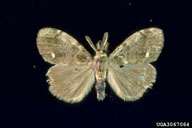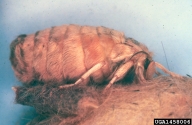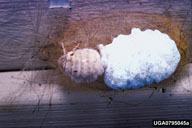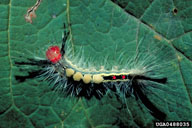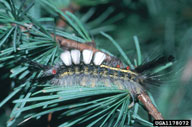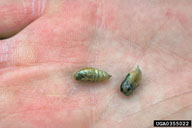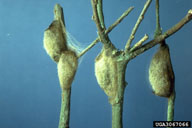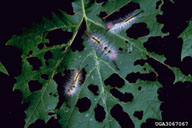Whitemarked tussock moth
Orgyia leucostigma (J. E. Smith) Lepidoptera: Lymantriidae)
Orientation to pest
Whitemarked tussock moth, Orgyia leucostigma (J. E. Smith), is a native North American tussock moth whose larvae feed on a variety of deciduous and coniferous trees. The species is found in most of eastern Canada and the eastern United States. This tussock moth passes the winter as eggs, which hatch in spring and thereafter young larvae often spin down on silk threads and balloon to new host plants. Young larvae skeletonize leaves of host trees, while older larvae consume whole leaves (eating all but the major veins). Cocoons are formed in bark crevices or between branches, and adults emerge in a few weeks. Females are wingless and lay eggs in masses. There are one or two generations per year depending on the region. Damage to forest trees is minor and this species is better known as a pest of shade or fruit trees in urban areas and in intensively managed plantations of Christmas trees.
Hosts commonly attacked
Whitemarked tussock moth exploits a broad range of plant species and has been reported to cause significant damage to many tree species, including apple (Malus), basswood (Tilia), elm (Ulmus), poplar (Populus), Norway maple (Acer platanoides L.), silver maple (Acer saccharinum L.), sycamore (Platanus), paper birch (Betula papyrifera Marsh.), yellow birch (Betula alleghaniensis Britt.), larch (Larix), and balsam fir (Abies balsamea [L.] Mill.).
Distribution
Whitemarked tussock moth is found throughout eastern Canada and the eastern United States.
Images of whitemarked tussock moth
| Figure 1. Adults of whitemarked tussock moth, Orgyia leucostigma: left, winged male; right, wingless female. | ||
| Figure 2. Flightless female of whitemarked tussock moth producing her egg mass | Figure 3. Larvae of whitemarked tussock moth: left, dorsal view; right, lateral view | |
| Figure 4. Left, pupae of whitemarked tussock moth (removed from cocoons); right, cocoons of whitemarked tussock moth | Figure 5. Feeding damage of whitemarked tussock moth larvae | |
Important biological control agents related to this pest species
Two strains of nucleopolyhedroviruses, one specific to whitemarked tussock moth and the other to Douglas fir tussock moth, Orgyia pseudotsugata (McDunnough), have been found to cause widespread mortality in populations of whitemarked tussock moth and are being developed as possible biological control agents in Christmas tree plantations (balsam fir) in eastern Canada.
Web links for information on whitemarked tussock moth
- Species Recognition and Habits Guide | L.L. Hyche, Auburn University
- A Field Guide to Common Texas Insects | AgriLife Extension, Texas A&M System
Articles
- Thurston, G. S. 2001. Orgyia leucostigma (J.E. Smith), whitemarked tussock moth (Lepidoptera: Lymantriidae), pp. 201-203. In: Mason, P. G. and J. T. Huber. Biological Control Programmes in Canada, 1981-2000. CABI Publishing, Wallingford, UK.
- Medina, R. F. and P. Barbosa. 2002. Predation of small and large Orgyia leucostigma (J. E. Smith) (Lepidoptera: Lymantriidae) larvae by vertebrate and invertebrate predators. Environmental Entomology 31: 1097-1102.
